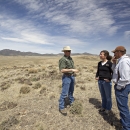Conservation banking is a market-based system for conserving species and their habitat. It consists of a partnership between a landowner, one or more government agencies, and the community of developers and others who implement or fund projects that adversely affect endangered or threatened species, candidate species, other species of concern. In exchange for permanently protecting and managing land for these species of interest, the U.S. Fish and Wildlife Service (Service) approves a specified number of habitat or species credits that the bank owners may sell to developers and other project proponents who need to offset project impacts to the same species occurring at another location within the community.
This type of arrangement for offsetting impacts is referred to as in-kind (referring to the same species or type of resource) and offsite (referring to impact and offset locations that are separated on the landscape). For example, a home builder purchases San Joaquin kit fox credits from a conservation banker to offset adverse impacts to this endangered species on his project site. The credits represent kit fox habitat located several miles from the project site. The banker will permanently protect and manage this habitat for kit foxes.
Who can participate?
Conservation banking offers opportunities for a variety of landowners through preservation of existing high-quality habitat, restoration of habitat in degraded areas, and/or establishment of habitat where needed to conserve particular species. Private, tribal, and government lands are all eligible to become conservation banks, although federal lands may require special consideration.
What are the benefits?
Landowners can make money selling credits while retaining title to their property and continuing with compatible land use practices.
Project proponents have an economical option for mitigating project impacts, because conservation banking takes advantage of economies of scale. Many small projects can be mitigated at a large conservation bank. Purchasing credits to offset project impacts shifts the liability for the success of the mitigation from the project proponent to the conservation banker.
Regulatory agencies save time and taxpayer dollars through reduced time spent on permitting and compliance activities. Establishing conservation banking programs may be additional work in the short term, but in the long term they are time savers.
Species benefit when adverse impacts to individuals or habitat are offset through conservation of large parcels of high-quality, well-managed habitat that contribute to landscape-scale conservation strategies.
Process
Step 1 - Contact Your Field Office
- Contact the Ecological Service Field Office that covers your area to see if there is a conservation banking program for the resources you could provide. If not, you may still be able to participate, but prepare to be a “pioneer” in your area and realize that the process can take a while.
Step 2 - Provide Information
- Provide the information needed to evaluate the eligibility of your property. You may be asked to provide biological survey results for certain species on the property, a title report to assess encumbrances that may limit your participation, and other information.
Step 3 - Conservation Banking Agreement
- If the Service gives conceptual approval of your property as a conservation bank, you will then need to cooperate on the development of a Conservation Bank Agreement (CBA). The CBA is a contract between you, the Service, and possibly other government agencies if you are also seeking credits for resources regulated by other agencies.
As a condition of the CBA, you will need to:
- (a) grant a perpetual conservation easement conservation easement
A conservation easement is a voluntary legal agreement between a landowner and a government agency or qualified conservation organization that restricts the type and amount of development that may take place on a property in the future. Conservation easements aim to protect habitat for birds, fish and other wildlife by limiting residential, industrial or commercial development. Contracts may prohibit alteration of the natural topography, conversion of native grassland to cropland, drainage of wetland and establishment of game farms. Easement land remains in private ownership.
Learn more about conservation easement to an appropriate organization; - (b) develop an adaptive management plan for the long-term stewardship of the property; and
- (c) fund an endowment to cover the long-term operation of the conservation bank property, including monitoring and management of the site.
Once all parties have agreed to the terms and conditions of the CBA and the document is executed, the Service will release the credits in accordance with the CBA.
The process can be complicated but being a conservation banker can be a rewarding partnership. Your local Ecological Service Field Office can provide more information or guidance.
Information on Service-approved conservation banks is available through the Regulatory In-lieu Fee and Bank Tracking System (RIBITS).
Audience
Get Started
Landowners/bankers are encouraged to contact the U.S. Fish and Wildlife Service field office in their area beforeproposing a conservation bank. The field office may have guidance, including a conservation strategy for the area, with which the landowner/banker will need to be familiar before selecting a bank site or developing a bank proposal.
